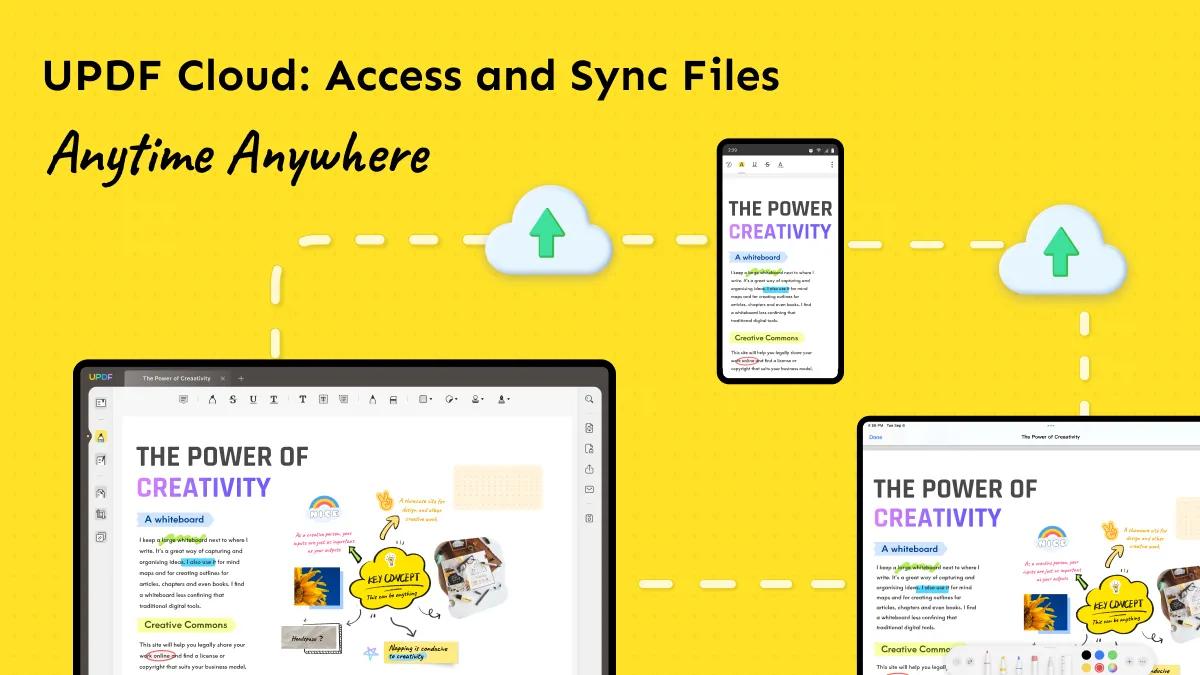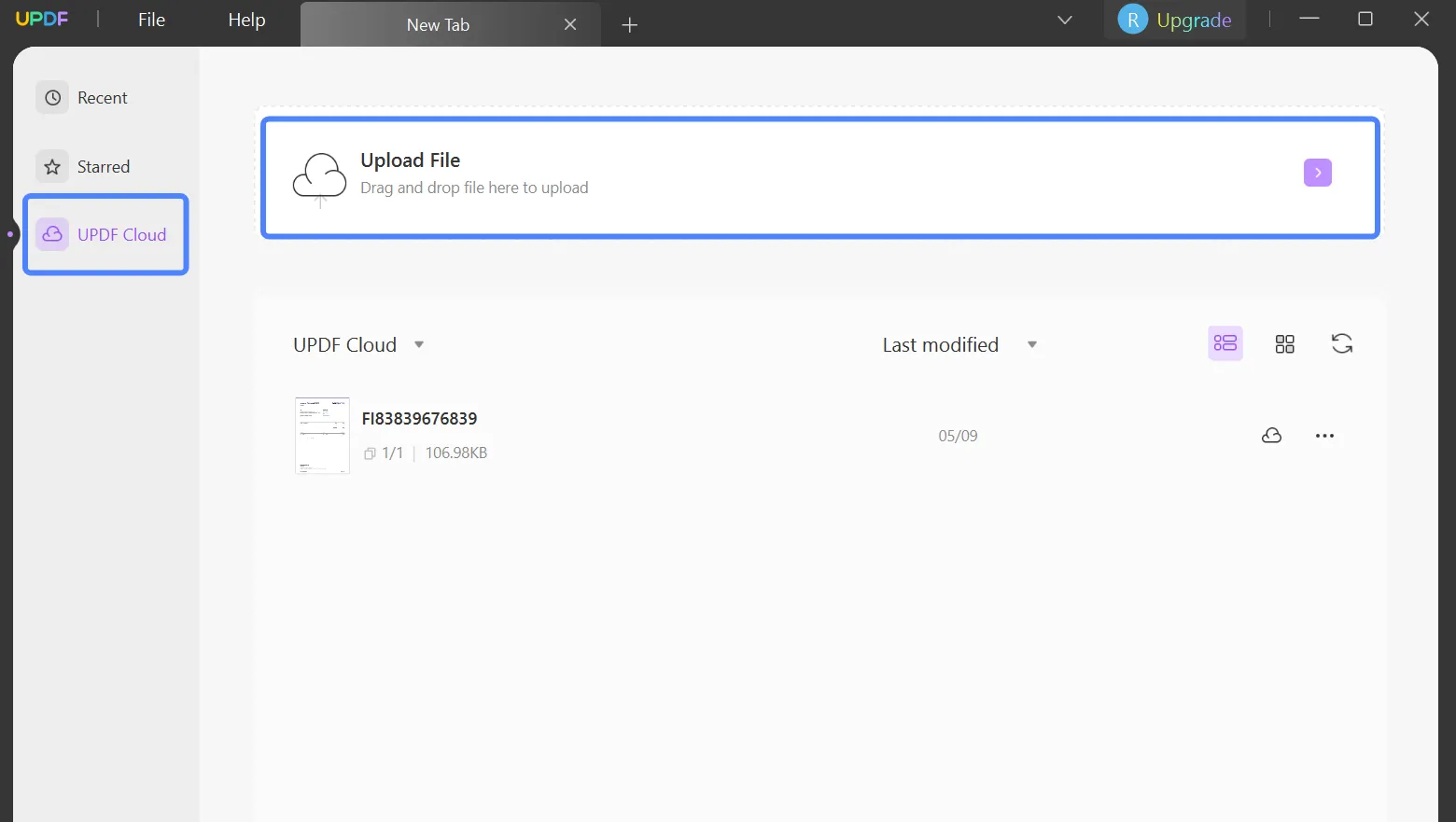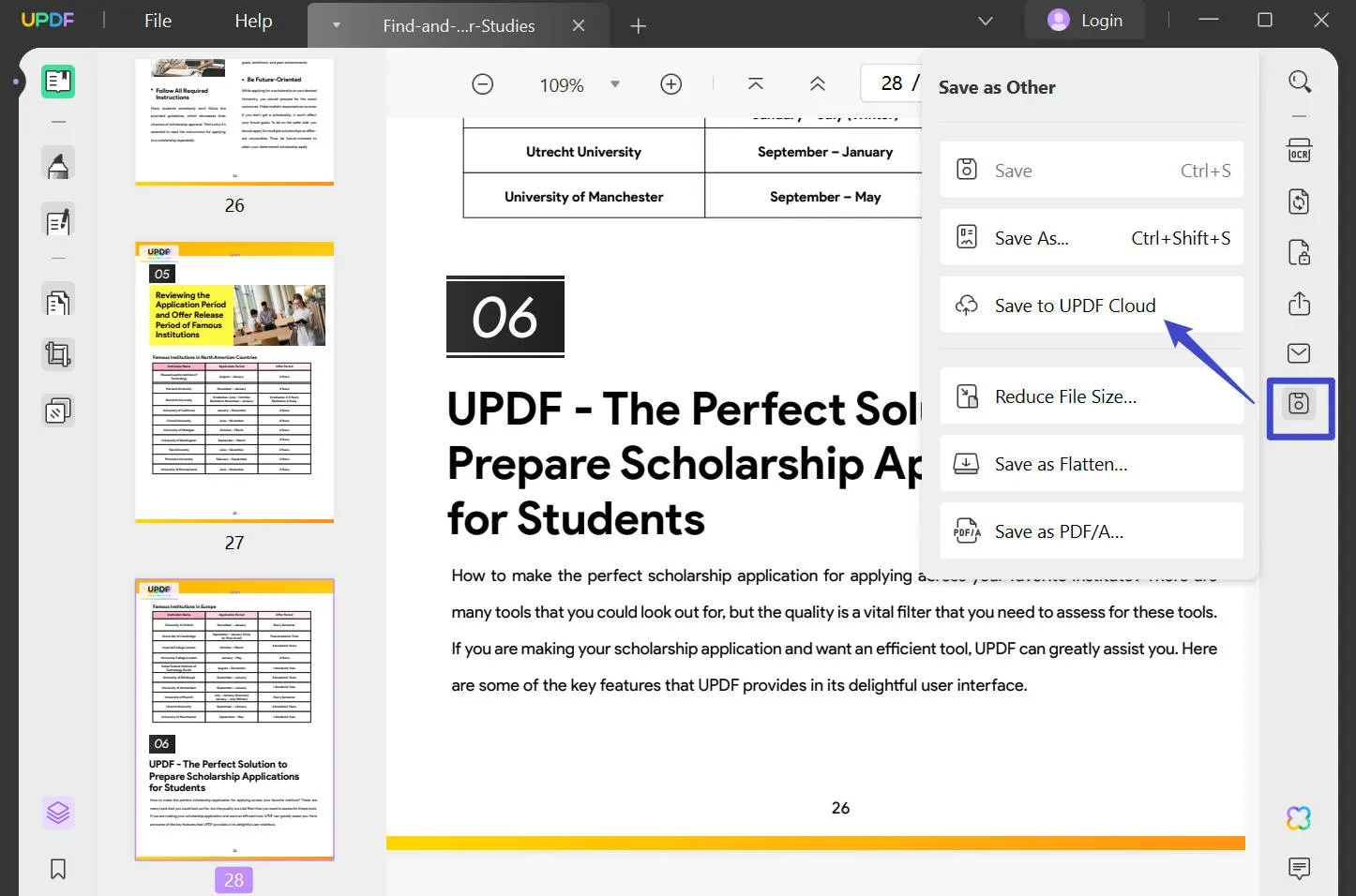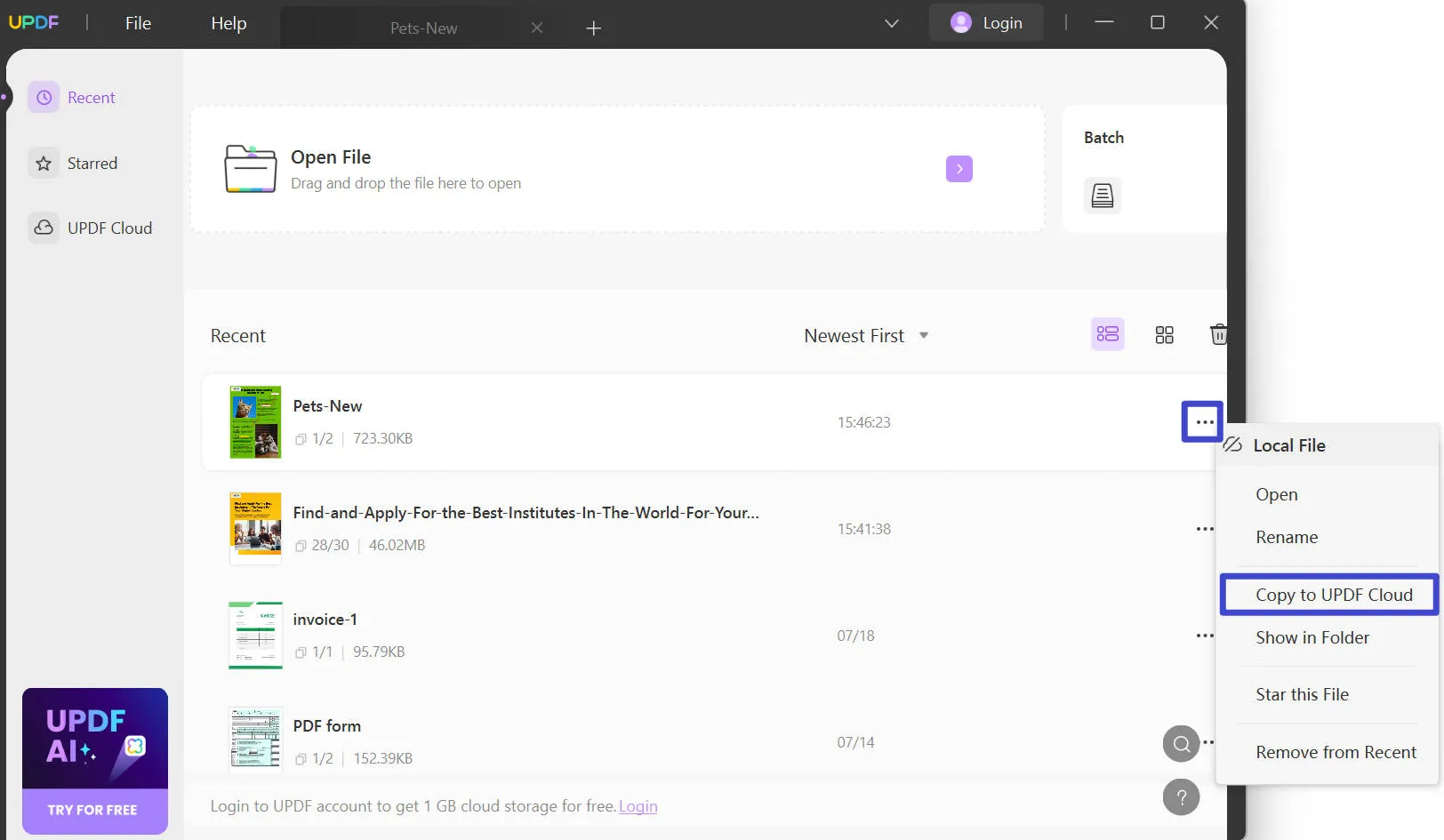Cloud storage has revolutionized the way we store and access our files, offering convenience, accessibility, and secure backups. To take full advantage of cloud storage, it's crucial to master the art of file upload. In this guide, we will explore three efficient methods that will enable you to seamlessly upload your files to the Cloud.
How to Upload Files to UPDF Cloud?
UPDF Cloud is a robust and feature-rich Cloud storage platform provided by UPDF, offering an array of powerful features to enhance your file management and accessibility. With UPDF Cloud, you can securely store and access your PDF files from anywhere, ensuring seamless collaboration and peace of mind.
Windows • macOS • iOS • Android 100% secure

In addition to its easy file upload methods, UPDF is an all-in-one PDF editor that assists you to view, annotate, edit, convert, OCR, protect, and share PDF files easily.
Let's explore in detail how to upload files to the cloud using three easy methods:
Method 1: Direct Upload
- Run UPDF and click the "UPDF Cloud" option on the left toolbar.
- Click on the "Upload file" button to initiate the upload process.
- Select the desired file from your local storage.
- UPDF Cloud will securely upload and store your file, ensuring it is readily available whenever you need it.

Method 2: Save to Cloud with the File Opened
Open your file from your local storage, and make some changes to it with UPDF. After the changes, you can save it directly to the cloud. Here's what you need to do:
- Open the file you want to upload in UPDF.
- Click on the "Save as" button on the right panel.
- From the available options, choose "Save to UPDF Cloud."
UPDF will seamlessly save the file to UPDF Cloud, making it accessible across multiple devices.

Method 3: Save to Cloud from Recent Files
UPDF allows quick access to recent files and enables easy saving to UPDF Cloud:
- Open UPDF and navigate to the "Recent Files" section.
- Locate the desired file you want to upload to UPDF Cloud.
- Click on the three dots next to the file.
- Choose "Copy to UPDF Cloud" from the options provided.
- UPDF PDF Software will promptly save the file to UPDF Cloud, ensuring secure storage and effortless access.

By utilizing these three convenient methods, you can effortlessly upload files to UPDF Cloud, providing seamless file management, enhanced collaboration, and reliable storage for your important documents.
Windows • macOS • iOS • Android 100% secure
What is Cloud Uploading?
Cloud uploading refers to the process of transferring files from a local device or computer to a remote server or Cloud storage platform over the Internet. It allows users to store and access their files securely from anywhere with an internet connection. Cloud uploading has become increasingly popular due to the numerous benefits it offers.
When you upload files to Cloud, they are stored in remote servers maintained by Cloud service providers. These servers are designed to offer high availability, scalability, and data redundancy. By leveraging Cloud uploading, users can free up local storage space, reduce reliance on physical storage devices, and ensure data backup and recovery options.
To upload files to Cloud, users typically use Cloud storage platforms or services provided by companies such as UPDF Cloud. These platforms offer user-friendly interfaces and various methods for file uploading, such as direct uploads from the web interface, file synchronization through dedicated software, or integration with other applications.
To upload files to Cloud, users can follow specific steps depending on the Cloud storage platform they choose. Typically, these involve selecting files from local storage, initiating the upload process, and confirming the successful transfer to the Cloud.
Is it Safe to Upload Files to Cloud Storage?
Yes, uploading files to the Cloud storage is generally considered safe as Cloud storage providers employ advanced security measures to protect user data. The security technology used in Cloud storage has matured significantly, ensuring the confidentiality, integrity, and availability of uploaded files.
Cloud storage providers, including UPDF Cloud, implement robust security protocols such as encryption, secure access controls, and data redundancy. Encryption techniques are used to protect data during transmission and while at rest in the Cloud servers. Secure access controls ensure that only authorized users can access the files.

UPDF Cloud, in particular, prioritizes the security and privacy of user data. They implement stringent security measures to safeguard files uploaded to their Cloud storage platform. This includes strong encryption standards, regular security audits, and adherence to industry best practices.
Windows • macOS • iOS • Android 100% secure
Perks of Uploading Files to the Cloud Storage
Uploading files to the Cloud storage offers numerous benefits compared to storing them solely on local devices. Here are some key advantages:
Convenience and Accessibility
Cloud storage allows you to access your files conveniently from any device with an internet connection. Whether you're using a computer, tablet, or smartphone, you can retrieve and work on your files anytime, anywhere.
Seamless File Sharing and Collaboration
Cloud storage simplifies file sharing with others. You can easily share files or folders with colleagues, clients, or friends, enabling effortless document collaboration and real-time editing, thereby boosting productivity.
Anti-Loss and Backup
By uploading files to the Cloud storage, you safeguard them against local device failures, accidental deletions, or physical damage like lost or broken devices. Your files remain secure and accessible, even if something happens to your local storage.
Storage Space Optimization
It alleviates the burden of limited storage space on local devices. Instead of filling up your computer or mobile device with files, you can offload them to the Cloud, freeing up valuable storage capacity and ensuring optimal device performance.
Enhanced Security
Cloud storage providers prioritize data security and employ robust security measures to protect your files. This often includes encryption, secure data transmission, access controls, and regular backups. Reputable providers like UPDF Cloud ensure the safety and privacy of your uploaded files.
Cost Savings
Uploading files to the Cloud storage can potentially save costs associated with purchasing and maintaining physical storage devices. Cloud storage solutions often offer flexible pricing plans, allowing you to pay for the storage you need, thereby reducing upfront hardware expenses.
Disaster Recovery
In the event of a natural disaster, theft, or hardware failure, Cloud storage ensures that your files remain safe and recoverable. Cloud servers are designed to provide redundancy and data replication, minimizing the risk of permanent data loss.
Environmental Sustainability
Cloud storage contributes to environmental sustainability by reducing the need for physical storage devices. It minimizes electronic waste and the carbon footprint associated with manufacturing and disposing of hardware.
Windows • macOS • iOS • Android 100% secure
FAQs on Uploading Files to Cloud
Here are a few FAQs on how to upload files to Cloud:
How to Upload Files to Google Drive?
- Sign in to your Google account and access Google Drive.
- Click on the "+ New" button and select "File Upload."
- Choose the files you want to upload from your local storage.
- Wait for the upload process to complete. The files will now be available in your Google Drive.
How to Upload Files to Dropbox?
- Sign in to your Dropbox account or create a new one.
- Click on the "Upload files" button, usually represented by an upward arrow.
- Select the files you want to upload from your computer.
- Alternatively, you can drag and drop files directly into your Dropbox folder.
- The files will begin uploading, and once completed, they will be accessible from your Dropbox account.
How to Upload Files to OneDrive?
- Sign in to your Microsoft account and access OneDrive.
- Click on the "Upload" button, typically represented by an upward arrow.
- Choose the "Files" or "Folder" option.
- Select the files you want to upload from your local storage.
- The files will start uploading to your OneDrive, and you can organize them into folders for easier access.
Wrap Up!
Whether you're a beginner or an experienced user, these methods will equip you with the knowledge to effortlessly transfer your files to Cloud storage platforms. Mastering these 3 efficient methods can help you upload files to Cloud with ultimate ease. With efficient Cloud platforms like UPDF, you can surely guarantee secure uploading without any hazards. Be sure to download it now!
Windows • macOS • iOS • Android 100% secure
 UPDF
UPDF
 UPDF for Windows
UPDF for Windows UPDF for Mac
UPDF for Mac UPDF for iPhone/iPad
UPDF for iPhone/iPad UPDF for Android
UPDF for Android UPDF AI Online
UPDF AI Online UPDF Sign
UPDF Sign Read PDF
Read PDF Annotate PDF
Annotate PDF Edit PDF
Edit PDF Convert PDF
Convert PDF Create PDF
Create PDF Compress PDF
Compress PDF Organize PDF
Organize PDF Merge PDF
Merge PDF Split PDF
Split PDF Crop PDF
Crop PDF Delete PDF pages
Delete PDF pages Rotate PDF
Rotate PDF Sign PDF
Sign PDF PDF Form
PDF Form Compare PDFs
Compare PDFs Protect PDF
Protect PDF Print PDF
Print PDF Batch Process
Batch Process OCR
OCR UPDF Cloud
UPDF Cloud About UPDF AI
About UPDF AI UPDF AI Solutions
UPDF AI Solutions FAQ about UPDF AI
FAQ about UPDF AI Summarize PDF
Summarize PDF Translate PDF
Translate PDF Explain PDF
Explain PDF Chat with PDF
Chat with PDF Chat with image
Chat with image PDF to Mind Map
PDF to Mind Map Chat with AI
Chat with AI User Guide
User Guide Tech Spec
Tech Spec Updates
Updates FAQs
FAQs UPDF Tricks
UPDF Tricks Blog
Blog Newsroom
Newsroom UPDF Reviews
UPDF Reviews Download Center
Download Center Contact Us
Contact Us









 Enid Brown
Enid Brown 

 Cathy Brown
Cathy Brown 